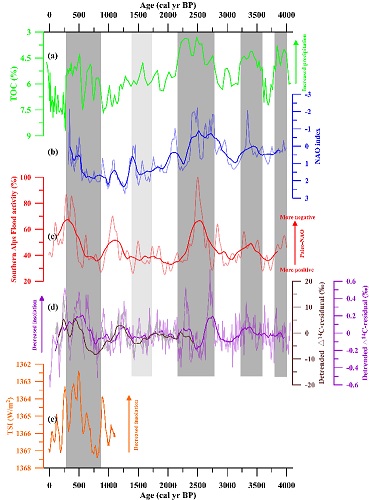Climate change and associated hydroclimatic variations can have important effects on the environment, ecology, and society. Due to the sparseness and short length of available instrumental records, detailing the nature of climate changes and its driving mechanisms during the late Holocene is essential for understanding both the regional and global climate dynamics. Moreover, it is important for accurately evaluating future climate trends in the context of anthropogenic climatic warming. The Tianshan Mountains are informally termed the “water tower of central Asia” and are the source of most large rivers in central Asia (e.g., the Tarim, Ili, Manas, and Syr-Darya rivers). Due to the fragile ecological environment, the consequences of future global warming at the high altitudes are expected to be more severe than in other regions. Therefore, the Tianshan Mountains are an important research focus for paleoclimate studies and future trends.
Dr. LAN Jianghu, from the Belt & Road Center for Earth Environment Studies and Limnological Environments & Processes Lab, Institute of Earth Environment, Chinese Academy of Sciences, collaborated with his colleagues, reconstructed the high-resolution late Holocene hydroclimatic variations and possible forcing mechanisms over the eastern central Asia, based on the total organic carbon, total nitrogen, and carbonate contents, carbon/nitrogen ratios, and grain size from Lake Sayram, central Tianshan Mountains, China.
This study revealed four periods of substantially increased precipitation at the interval of 4000-3780, 3590-3210, 2800-2160, and 890-280 cal yr BP, and one period of slightly increased precipitation from 1700-1370 cal yr BP. These wetter periods broadly coincide with those identified in other records from the mid-latitude westerlies-dominated eastern central Asia, including the northern Tibetan Plateau. As such, a similar hydroclimatic pattern existed over this entire region during the late Holocene. Based on a close similarity of Sayram Lake record with reconstruction of North Atlantic Oscillation indices and solar irradiance, the authors propose that decreased solar irradiance and southern migration of the entire circum-North Atlantic circulation system, particularly the main pathway of the mid-latitude westerlies, significantly influenced hydroclimate in eastern central Asia during the late Holocene. Finally, the inferred precipitation at Lake Sayram has increased markedly over the past 100 years, although this potential future changes in hydroclimate in Central Asia need for further investigation.
This study was recently published in Science China Earth Sciences. The work was funded by the National Natural Science Foundation of China (Grant Nos. 41672169, 41473120 & 41502171) and the Youth Innovation Promotion Association of Chinese Academy of Sciences (Grant No. 2012295). This study is a part of the “Belt & Road” project of the Institute of Earth Environment, Chinese Academy of Sciences.

Comparison of the precipitation record from Lake Sayram ((a), this study) with a reconstruction of the NAO index ((b), Olsen et al., 2012), Southern Alps flood activity ((c), Wirth et al., 2013), de-trended △14C-residual ((d), Stuiver et al., 1998; Reimer et al., 2004), and total solar irradiance ((e), Bard et al., 2000).
Contact: Bai Jie, Institute of Earth Environment, Chinese Academy of Sciences, Xi'an, China. Email:baijie@ieecas.cn
 © 2015 Institute of Earth Environment,CAS
© 2015 Institute of Earth Environment,CAS Address:No. 97 Yanxiang Road, Xi'an 710061, Shaanxi, China

 Location :
Location :